The Intel Skylake i7-6700K Overclocking Performance Mini-Test to 4.8 GHz
by Ian Cutress on August 28, 2015 2:30 PM ESTLinux Performance
C-Ray: link
C-Ray is a simple ray-tracing program that focuses almost exclusively on processor performance rather than DRAM access. The test in Linux-Bench renders a heavy complex scene offering a large scalable scenario.
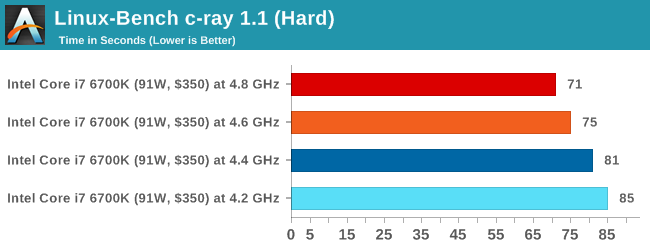
NAMD, Scalable Molecular Dynamics: link
Developed by the Theoretical and Computational Biophysics Group at the University of Illinois at Urbana-Champaign, NAMD is a set of parallel molecular dynamics codes for extreme parallelization up to and beyond 200,000 cores. The reference paper detailing NAMD has over 4000 citations, and our testing runs a small simulation where the calculation steps per unit time is the output vector.
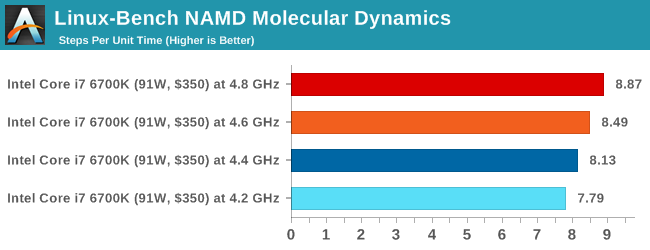
NPB, Fluid Dynamics: link
Aside from LINPACK, there are many other ways to benchmark supercomputers in terms of how effective they are for various types of mathematical processes. The NAS Parallel Benchmarks (NPB) are a set of small programs originally designed for NASA to test their supercomputers in terms of fluid dynamics simulations, useful for airflow reactions and design.
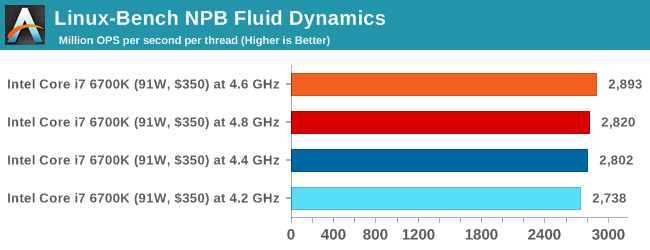
Redis: link
Many of the online applications rely on key-value caches and data structure servers to operate. Redis is an open-source, scalable web technology with a strong developer base, but also relies heavily on memory bandwidth as well as CPU performance.
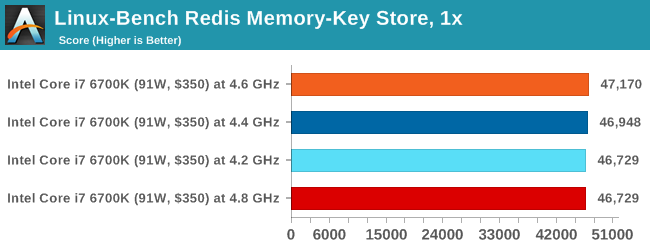
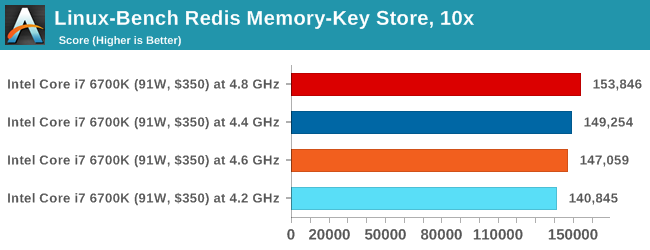
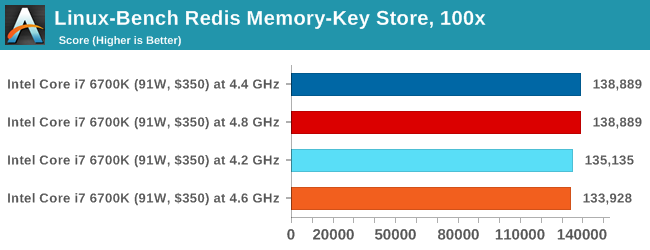
Conclusions on Linux-Bench
Our Linux testing actually affords ten tests, but we chose the most important to publish here (the other results can be found in Bench). But here we see some slight differences when it comes to overclocks - the NPB tests rely on multi-dimensional matrix solvers, which are often more cache/memory dependent and thus a higher frequency processor doesn't always help. With Redis, we are wholly cache/memory limited here. The other results are in-line with CPU performance deltas over the overclock range.










103 Comments
View All Comments
StrangerGuy - Sunday, August 30, 2015 - link
If we keep dropping the OC multi on Skylake we are going into single-digit clock increases territory from 4GHz stock :)Yeah, I wonder why AT mentioned in their Skylake review about why people are losing interest in OCing despite Intel's claims of catering to it. From the looks of it, their 14nm process simply isn't tuned for 4GHz+ operation but towards the lower clocked but much more lucrative chips for the server and mobile segment.
qasdfdsaq - Wednesday, September 2, 2015 - link
Then you are deluded. There are edge cases and scenarios that will cause a hardware crash on a Xeon server with ECC RAM at stock speeds, so by your reckoning *nothing* is ever 100% stable.danjw - Friday, August 28, 2015 - link
When can we expect a platform overview? You reviewed the i7-6700K, but you didn't have much in details about them. You were expecting that from IDF. IDF is over, so is there an ETA?MrBowmore - Friday, August 28, 2015 - link
+1hansmuff - Friday, August 28, 2015 - link
I assume the POV-Ray score is the "Render averaged PPS"?My 2600K @4.4 gets 1497 PPS, so a 35% improvement compared to 6700k @4.4
hansmuff - Friday, August 28, 2015 - link
And of course I mean the 6700k seems to be 35% faster in POV... sigh this needs an edit buttonlooncraz - Saturday, August 29, 2015 - link
POV-Ray has been seeing outsized performance improvements on Intel.From Sandy Bridge to Haswell sees a 20% improvement, when the overall improvement is closer to 13%.
HandBrake improved even more - a whopping 29% from Sandy Bridge to Haswell.
And, of course, I'm talking core-for-core, clock-for-clock.
I suspect much of this improvement is related to the AVX/SIMD improvements.
Just hope AMD focused on optimizing for the big benchmark programs as well as their server target market with Zen (this is past tense since Zen is being taped out and currently being prototyped.. rumors and some speculation, of course, but probably pretty accurate).
zepi - Sunday, August 30, 2015 - link
One has to remember, that "handbrake" doesn't actually use CPU-resources at all. The process that is actually benchmarked is running x264 codec with certain settings easily accessible by using GUI called handbrake.If x264 or x265 programmers create new codepaths inside the codecs that take benefit of new architecture, it received huge performance gains. But what this actually means is that Sandy Bridge and Skylake actually run different benchmarks with different instructions fed to processors.
Do I care? No, because I just want my videos to be transcoded as quickly as possible, but one should still remember that this kind of real world benchmarks don't necessarily run same workloads on different processors.
MrBowmore - Friday, August 28, 2015 - link
When are you going to publish the runthrough of the architechture?! Waiting impatiently! :)NA1NSXR - Friday, August 28, 2015 - link
Sigh, still no BCLK comparisons at same clocks. What would really answer some unanswered questions would be comparing 100 x 40 to 200 x 20 for example.